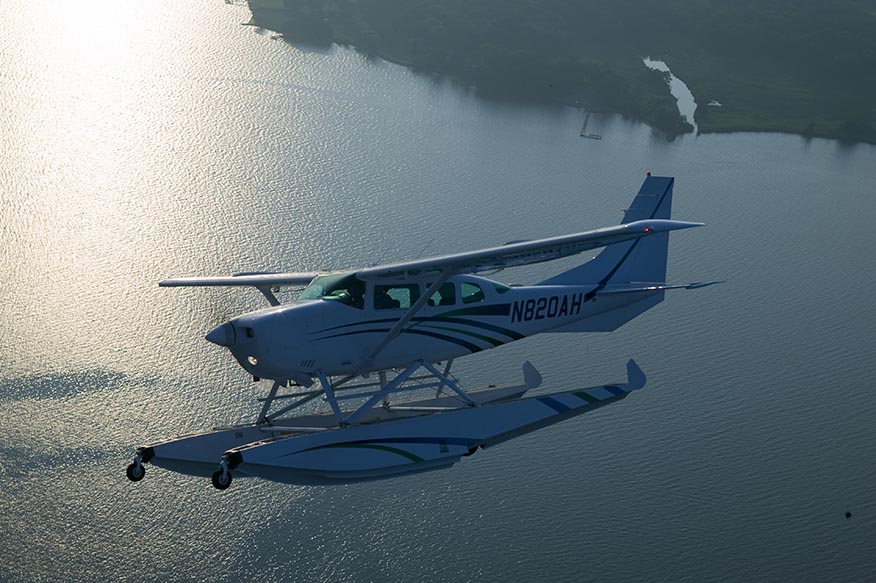CONCLUSIONS AND RECOMMENDATIONS

Most ARC accidents—the number one accident cause—were gear-down water landing.
Conclusions
Seaplane pilots will benefit from additional training in aircraft control, loss of control prevention, gear configuration, and operations during maneuvering. Installation and use of angle of attack indicators along with gear warning and surface identification indicators will help reduce two main seaplane accident causes—abnormal runway contact (ARC) and loss of control in flight (LOC-I).
Most ARC accidents—the number one accident cause—were gear-down water landings. Efforts that ensure pilots have properly configured for the type of landing they will perform is critical to preventing these types of accidents. Although training programs currently exist, bringing this training to a wider audience and targeting specific operators (i.e., amphibian) may help reduce these accidents. Additionally, the broader installation of gear warning and advisory systems, which work to identify the landing surface and inform pilots of proper surface or water gear configuration, may drastically reduce nose-over events. While not as deadly as LOC-I, reducing the volume of accidents would, most likely, positively impact the cost and availability of insurance.
The second accident cause—and most deadly type—are LOC-I accidents. Efforts to provide training on aircraft control and placing emphasis on the common, seaplane-specific, loss-of-control locations should help reduce the overall number of accidents. Initial climb and maneuvering should have dedicated focus and targeted training.
The number one NTSB finding for seaplane accidents was the pilot’s inability to control the aircraft. Efforts dedicated to loss of control prevention should reduce fatal and non-fatal outcomes. Decision making—a key contributor and second most prevalent NTSB finding—underpins accidents in general.
Safety starts and ends with good decisions. Reminding pilots of the effect their choices have on the outcome of the flight and helping them understand how to mitigate risks will further reduce all GA accidents.
Prevention
Training designed to mitigate high-risk areas and improve pilot airmanship has shown success in other areas of general aviation. Scenario based training (SBT) mirrors normal day-to-day operational flights, creating the opportunity to learn in a more realistic environment. Subject matter experts should create training scenarios that target elevated risk areas of flight and seaplane envelope challenges. A seaplane-specific training program with an emphasis on accident prevention should include aircraft control, low-speed awareness, stabilized approach, checklist usage, and decision making. In addition, the AOPA Air Safety Institute’s Focused Flight Review program provides seaplane pilots targeted pilot proficiency to help reduce accidents (see the accompanying ASI’s Focused Flight Review sidebar).
Seaplane operations’ seasonality creates opportunity for training gaps. Operators swap floats for skis or wheels as the seasons change. Seaplane pilots may experience six or more months away from seaplane operations, a situation that hinders their proficiency and impacts their training. Pilots who experience gaps due to seasonality need to take added precautions when resuming seaplane operations. Combating these gaps through a training course could help mitigate proficiency related accidents.
Given gear-down water landings are high among ARC accidents, specialized training on amphibian systems and when to make configuration changes can mitigate these accidents. Adoption of technologies that alert pilots to misconfiguration for the given landing surface can quickly reduce or eliminate nose-over events. Stabilized approaches and better wind determination can further reduce ARC accidents. Additionally, the Seaplane Pilots Association’s “Positive rate, gear up” campaign provides another avenue for pilot training in ARC prevention.
Loss of control on the ground (LOC-G) is another area where training can reduce accident frequency. Proper control inputs along with understanding the effects of wind would help mitigate risks. Sea state and directional control also remain problem areas for accident pilots. Training focused on rough-water operations and crosswind takeoffs and landings could reduce overall LOC-G accidents.
Safety starts and ends with good decisions. Reminding pilots of the effect their choices have on the outcome of the flight and helping them understand how to mitigate risks has had a positive impact on across-the-board accident reduction.
AOPA Air Safety Institute Recommendations
- Encourage seaplane pilot participation in the FAA activity survey
- Encourage seaplane-specific training at seasonal intervals, using the ASI Focused Flight Review program’s seaplane profile
- Accentuate importance of seasonal proficiency and “rusty” starts to season
- Improve stick and rudder skills, with emphasis on seaplane-specific configurations (e.g., maneuverability on floats versus wheels and low-speed control)
- Install angle of attack indicators
- Broaden installation of gear warning/alerting systems designed for land and water operations
- Encourage all seaplane pilots to participate in SPA’s “Positive rate, gear up” campaign
- Conduct seaplane-specific decision-making training with a focus on wind and water conditions along with stabilized approaches
ASI’s Focused Flight Review
The AOPA Air Safety Institute’s Focused Flight Review includes a seaplane profile that expands awareness of maneuvering hazards in seaplanes and offers tips on positive aircraft control. The three-step, scenario-based profile includes planning and discussion of an actual or simulated seaplane flight at multiple bodies of water to help pilots improve their ability to maneuver safely in dynamic flight environments. The profile also discusses the critical topics of assessing water conditions, docking and undocking procedures, and considerations for airframe icing.
SPA’s Safe Amphibious Gear Operations
The Seaplane Pilots Association’s online training programs offer a video and 10-question test, developed by the Seaplane Foundation in cooperation with numerous float manufacturers and seaplane instructors. SPA encourages seaplane pilots—especially those who own or operate amphibious seaplanes—to watch the video and learn the reasons for gear-down water landings and the recommended procedures to avoid these situations. SPA suggests seaplane pilots view the video and take the test annually.
AOA Indicators
Join us as we take a look at the benefits of angle of attack indicators, and how they provide pilots with a visual reference on how close their wings are to stalling.